Mercedes powered McLaren and their drivers to four world championships and 78 race wins in two decades before the pair split in 2014.
The two have reunited and McLaren will launch their first Mercedes-powered car for seven years today. How will it measure up to its predecessors? Take a look at all 20 of them, from the title-winners to the one that never even started a race.
1995 McLaren MP4-10, MP4-10B and MP4-10C
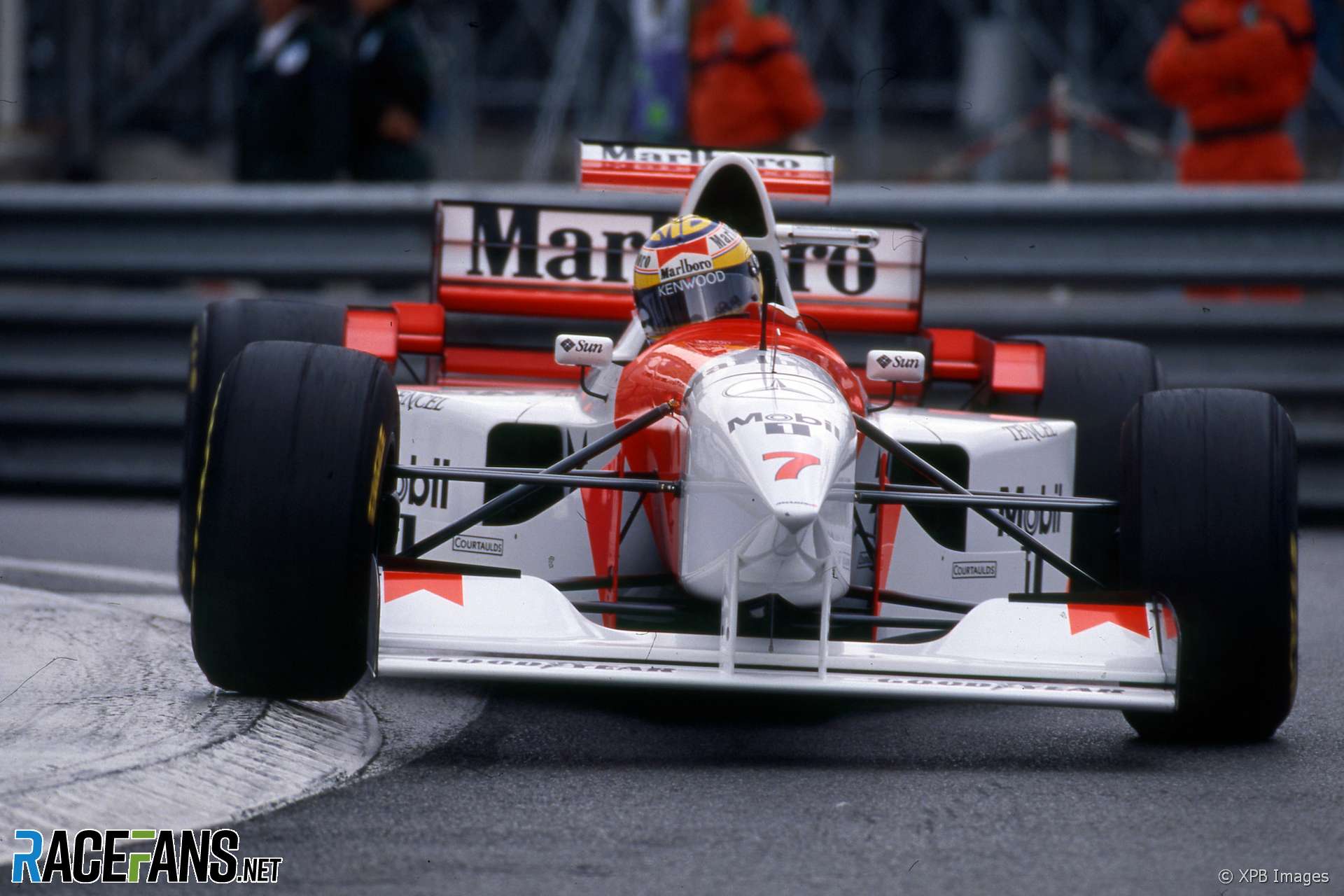
17 races, 0 wins, 0 poles, 30 points
McLaren agreed terms with Mercedes during their poor 1994 campaign with Peugeot, which ended without a win. But the new partnership didn’t get off to a great start: Nigel Mansell didn’t comfortably fit into the MP4-10 and missed the opening races as a result. He only did two races in the widened MP4-10B before walking out, leaving the car to Mark Blundell. A further revised C-spec car was introduced for the Portuguese Grand Prix, to little avail.Jan Magnussen made a one-off appearance in place of an unwell Mika Hakkinen at the Pacific Grand Prix, but on his return Hakkinen took an encouraging second at Suzuka. The year ended badly, however, when Hakkinen was injured in a frightening crash at Adelaide.
1996 McLaren MP4-11
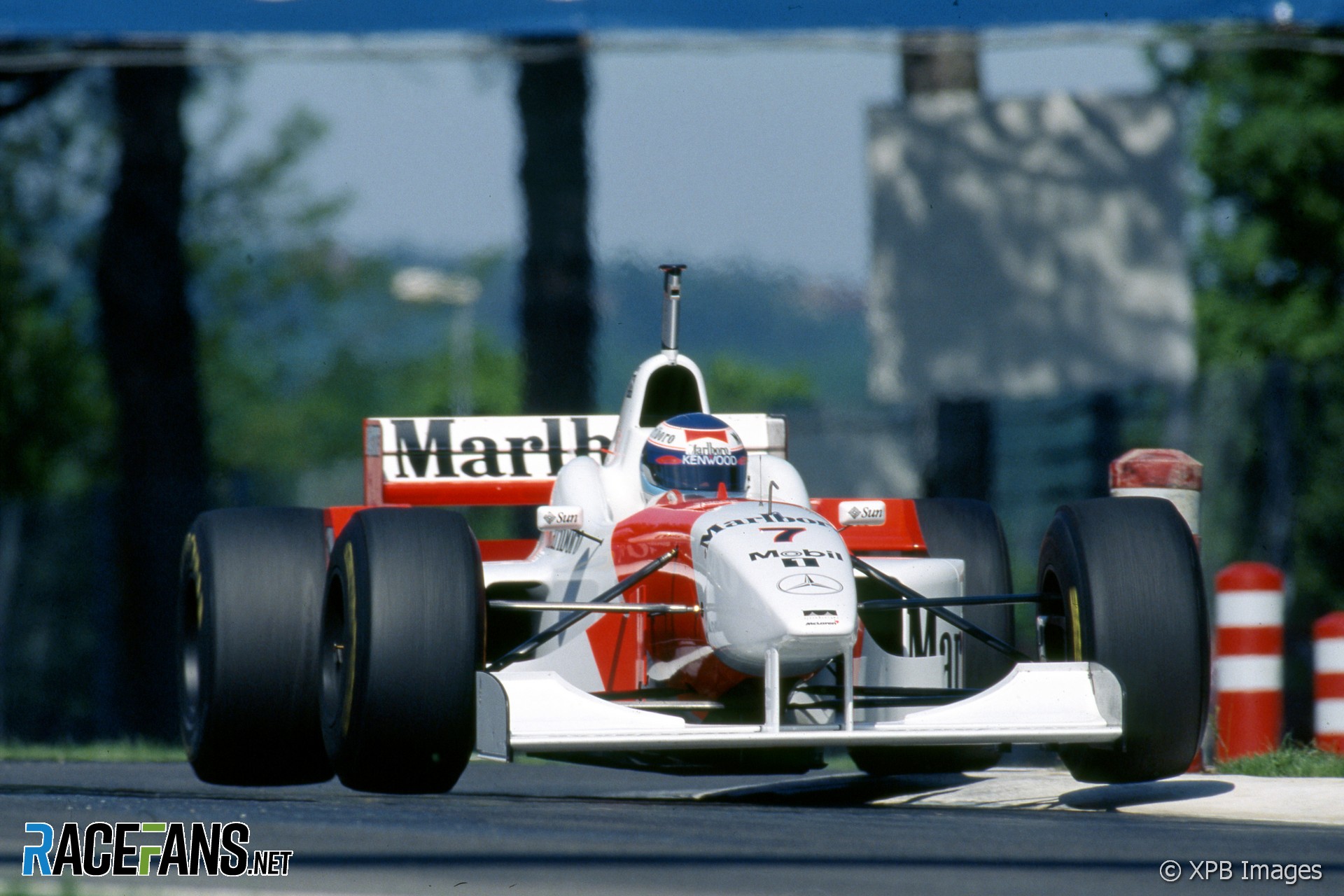
16 races, 0 wins, 0 poles, 49 points
Race-winner David Coulthard was lured from Williams to replace Blundell, but McLaren and Mercedes failed to reach the top step in an otherwise improved 1996 campaign. On the technical side Steve Nichols returned and the team made clear progress as the season progressed. Long-time title sponsor Marlboro switched to Ferrari at the end of the year, and McLaren embraced Mercedes silver colouring through another tobacco brand.
Advert | Become a RaceFans supporter and
1997 McLaren MP4-12

17 races, 3 wins, 1 pole, 63 points
McLaren’s technical operation was further bolstered by the hiring of Adrian Newey in 1997, though his focus was the team’s 1998 car, which was built to drastically overhauled technical regulations. Nonetheless Mercedes’ consistently improving engine helped the team win its first race for three years at the season-opener, courtesy of Coulthard. He added another at Monza and could have done the same at Jerez, but complied with his team’s request to let Hakkinen through.
1998 McLaren MP4-13

16 races, 9 wins, 12 poles, 156 points
Unlucky 13? Not a bit of it. The MP4-13 put McLaren back on top. Its combination of Newey-honed aerodynamics, a potent Mercedes engine plus a timely switch to Bridgestone tyres – with rivals Goodyear on the verge of quitting – made for a supremely competitive machine. One of its innovations – a third pedal for independent brake control which had been introduced on its predecessor – caught the eye of the sport’s governing body and was banned. But that didn’t stop the team sweeping both titles, Hakkinen claiming the drivers championship.
Advert | Become a RaceFans supporter and
1999 McLaren MP4-14

16 races, 7 wins, 11 poles, 124 points
While Hakkinen doubled up, McLaren lost the constructors’ title to Ferrari. The MP4-14’s drivers also found it somewhat more unforgiving than its predecessor – Hakkinen spun away chances to win both Italian rounds. Coulthard picked up a pair of wins as well, but didn’t endear himself to the team by letting Eddie Irvine in to win the Austrian Grand Prix after knocking Hakkinen into a spin at the start.
2000 McLaren MP4-15
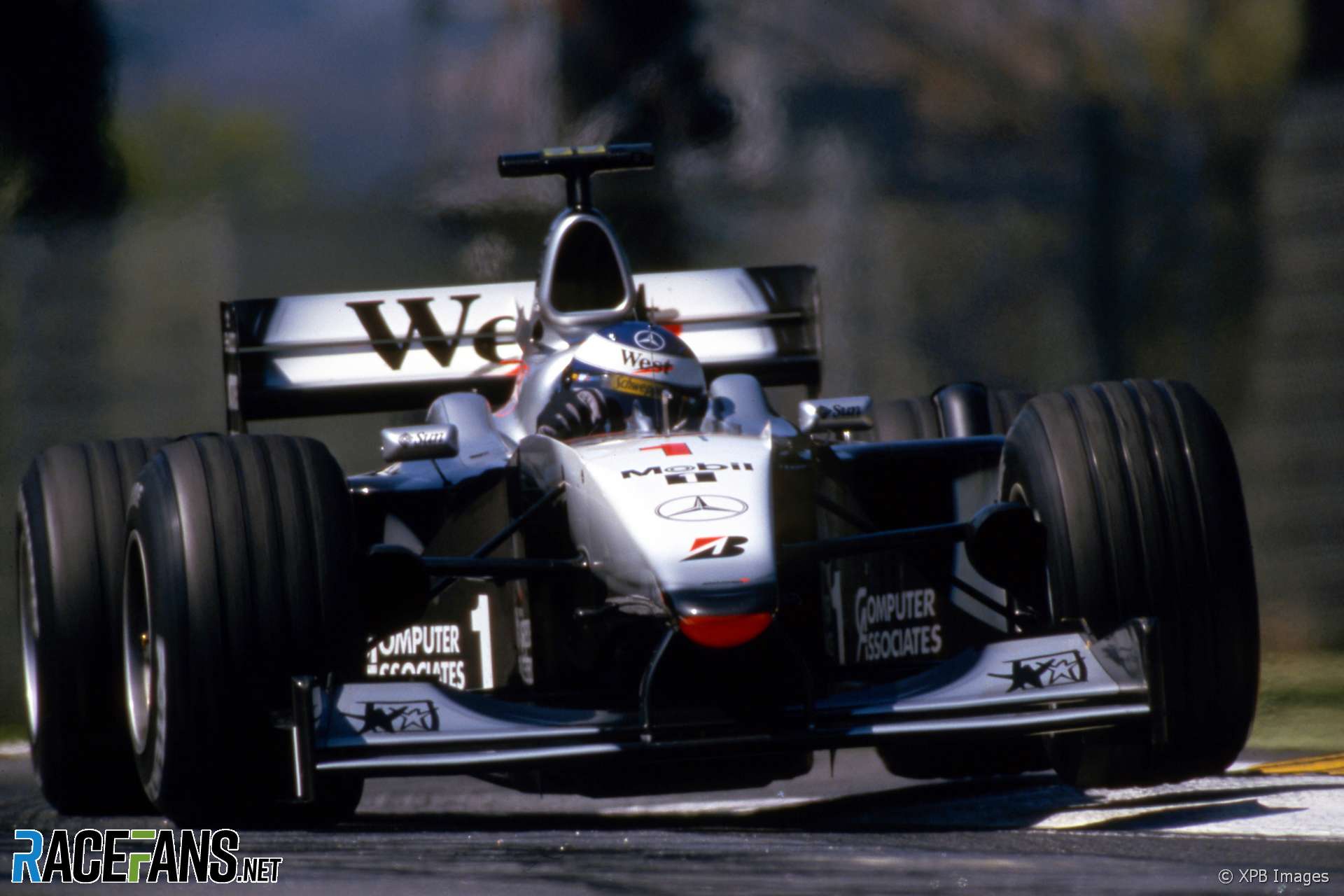
17 races, 7 wins, 7 poles, 162 points
Ferrari finally got the better of McLaren in 2000, when reliability problems with the MP4-15 blunted their early-season campaign. Hakkinen lost his hard-won championship lead to Michael Schumacher at Indianapolis when his engine let go. Ominously for the team, Ferrari were increasingly a match for them in outright performance as well, taking pole position for 10 of the 17 races.
2001 McLaren MP4-16

17 races, 4 wins, 2 poles, 102 points
By 2001 the McLaren drivers had over 800bhp from their Mercedes V10s, despite a ban on the use of beryllium which forced some changes to their engines. But Ferrari were now more than a match for them in several key areas: power, downforce and reliability. Hakkinen seemed out of sorts for much of the season and opted for a sabbatical at the end of the year, which in due course turned out to be a full retirement. Coulthard took up the fight in the drivers championship but with four races to go it was all over.
2002 McLaren MP4-17 and 2003 McLaren MP4-17D
33 races, 3 wins, 2 poles, 207 points
With Bridgestone’s development effort increasingly centred around Ferrari, McLaren switched to Michelin rubber for 2002. But the MP4-17, honed the team’s new wind tunnel, was neither quick nor reliable enough to mount a title bid.
Coulthard scored its only victory in Monaco – payback for the electronics glitch which prevented him starting the previous year’s race from pole position – and new team mate Kimi Raikkonen should have taken his first win at Magny-Cours, only to skid wide on oil dropped by Allan McNish’s Toyota. That allowed Schumacher in to win and wrap the title up with six races to spare.
Stung by Ferrari’s crushing dominance, McLaren began 2003 with an evolution of the previous year’s car while honing a more radical machine for later introduction. However the upgraded 2002 machine proved enough for Raikkonen to keep Schumacher honest in the title fight until the final round, and the new car was put on ice until the following year.
2003 McLaren MP4-18A

0 races, 0 wins, 0 poles, 0 points
In a bold attempt to propel themselves back to the top, McLaren readied a revolutionary new design incorporating a more compact Mercedes FO 110P V10, a carbon fibre gearbox casing and aggressively tight packaging for maximum aerodynamic benefit. But it failed to run reliably in testing and was never raced.
2004 McLaren MP4-19A and MP4-19B

18 races, 1 win, 2 poles, 69 points
By 2004 the team finally had a race-ready evolution of the MP4-18A. Outwardly similar to the unraced car, it made greater concessions towards reliability as, for the first time, teams were required to use a single engine for an entire race weekend. But it proved a step backwards on the track at the beginning of the year, and McLaren quickly took the decision to produce a B-spec version with revised aerodynamics. This was pressed into service at mid-season and Raikkonen took the team’s only win with it at Spa, providing some distraction from Schumacher’s fifth consecutive title triumph.
2005 McLaren MP4-20

18 races, 10 wins, 7 poles, 182 points

However Raikkonen suffered technical failures at Imola and the Nurburgring while leading, and also fell foul of the new two-race engines rule. That cost him points in his fight with eventual champion Fernando Alonso. He did take a magnificent win at Suzuka, but in the Shanghai finale Renault denied McLaren the constructors title in the final race for V10 engines.
2006 McLaren MP4-21
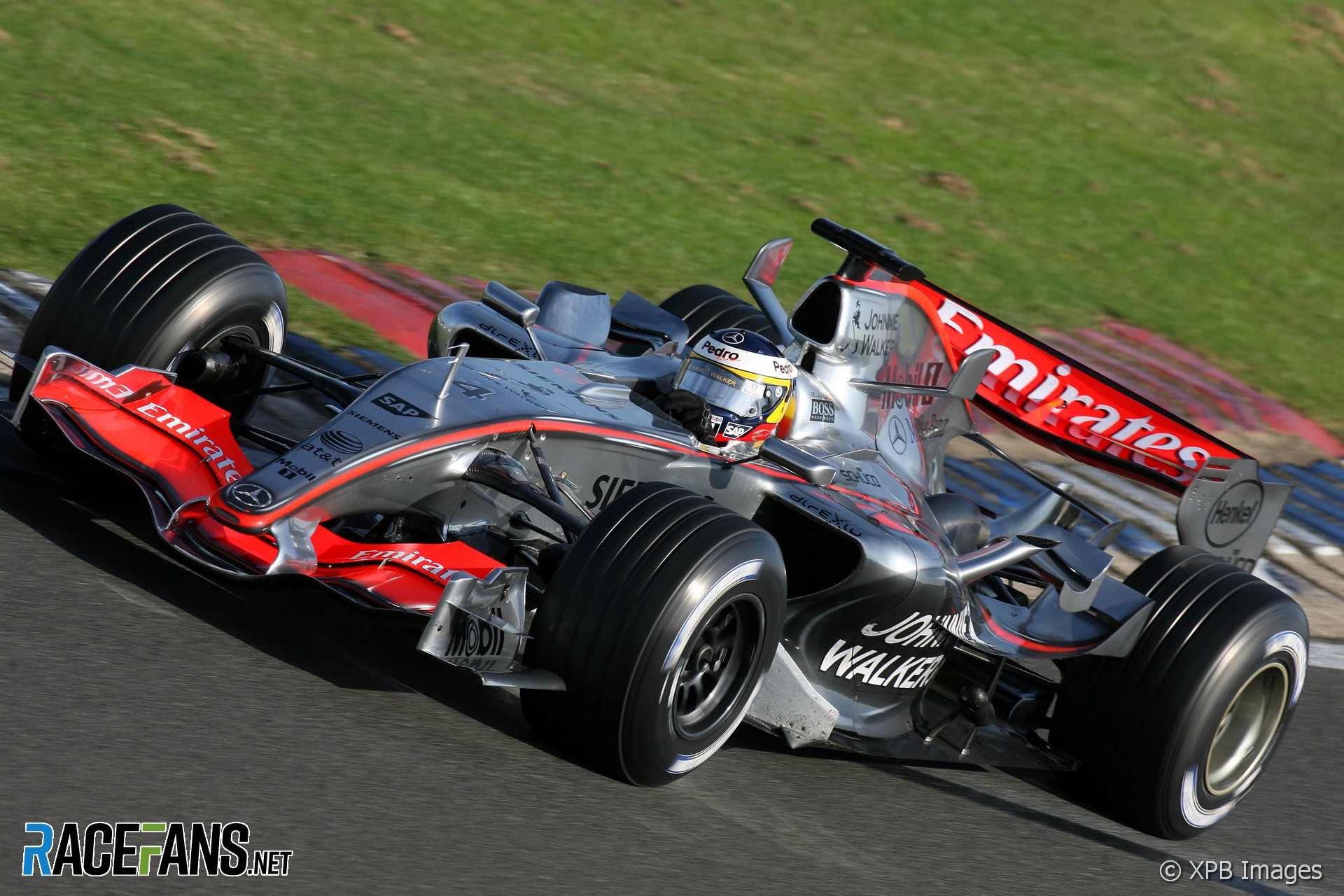
18 races, 0 wins, 3 poles, 110 points
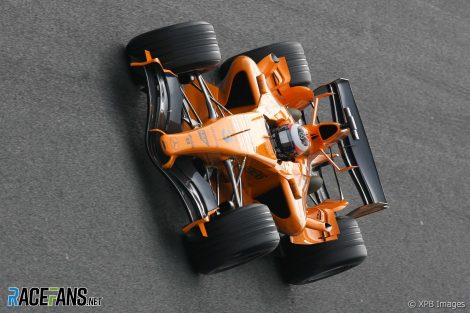
The situation wasn’t help by upheaval on the driving side, as Juan Pablo Montoya left the team at mid-season following a collision with Raikkonen at Indianapolis. Pedro de la Rosa took his place. But for the first time in 10 years, McLaren and Mercedes ended a season win-less.
2007 McLaren MP4-22

17 races, 8 wins, 8 poles, 218 points
It should have been a season of triumph for McLaren and Mercedes, but it ended in bitter acrimony. With Raikkonen off to Ferrari, reigning world champion Alonso joined as his replacement, while the impressive GP2 champion Lewis Hamilton became the first driver in 12 years to make his debut in a McLaren. They won four races each but ended the year one point behind Raikkonen after an astonishing finale.
The team was also found guilty of using intellectual property supplied by a disgruntled ex-Ferrari employee, fined a jaw-dropping $100 million, and thrown out of a championship they could have won.
2008 McLaren MP4-23

18 races, 6 wins, 8 poles, 151 points
The MP4-23 was launched at the Mercedes-Benz Museum in Stuttgart, Heikki Kovalainen having joined in place of Alonso. The new car was inspected by the FIA to provide necessary assurances no Ferrari IP had been used.
But McLaren rebounded from its humiliating 2007 season superbly, Hamilton avenging the title he narrowly lost the year before. There were several dramas along the way, notably when he crashed into Raikkonen in the pits at Montreal and was stripped of victory at Spa on questionable grounds. Yet even those paled in comparison to the unforgettable title-decider where Hamilton lost the championship lead in the dying laps, only to regain it at the final corner.
2009 McLaren MP4-24
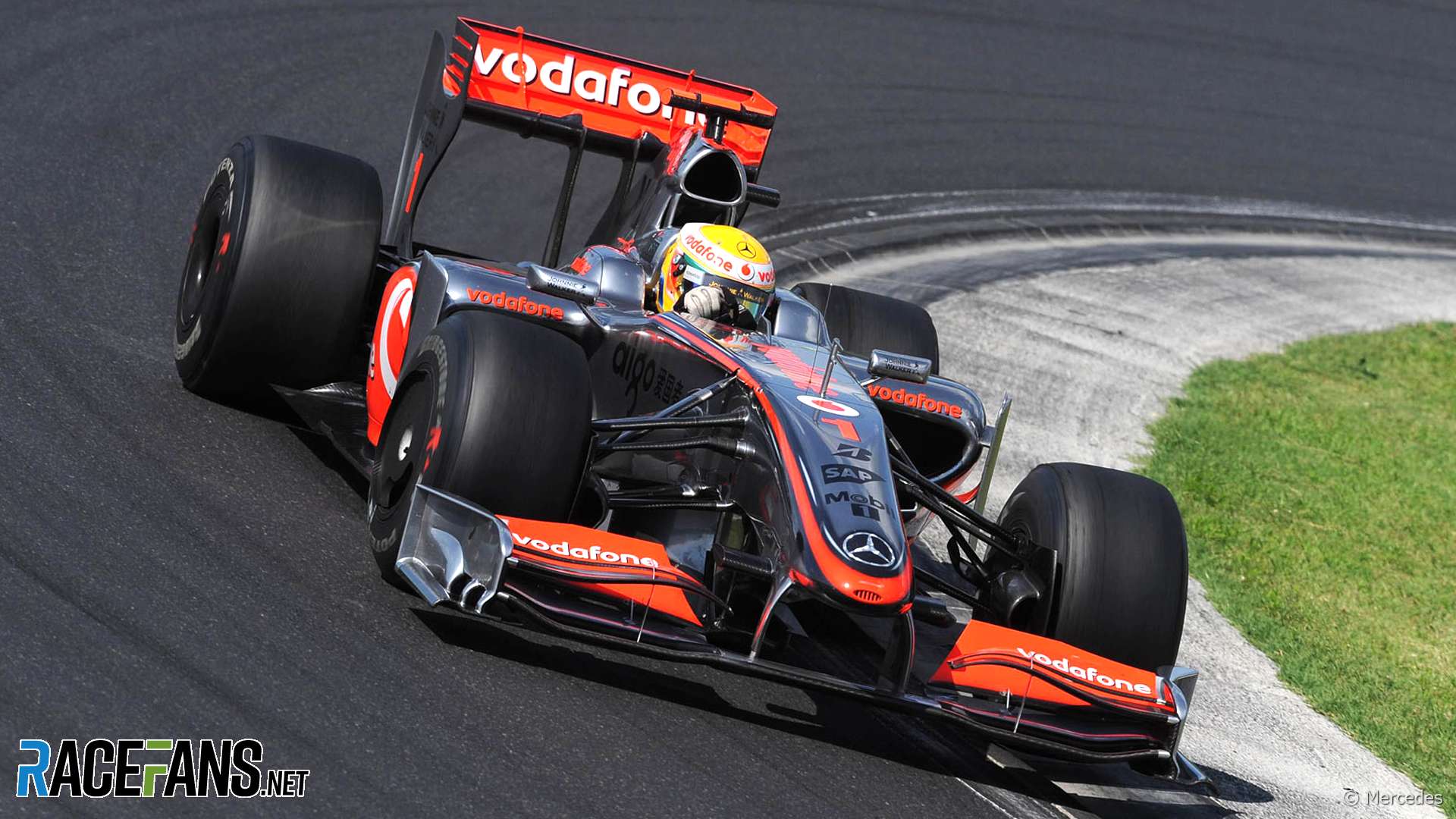
17 races, 2 wins, 4 poles, 71 points
McLaren didn’t immediately get a handle on the new aerodynamic regulations which were introduced for the 2009 season, and took until mid-season to ready an upgrade for their MP4-24 which brought them on terms with the likes of Brawn GP and Red Bull. Mercedes, however, made a fine job of its Kinetic Energy Recovery System – the first taking advantage of rules permitting greener F1 engines – and Hamilton scored the first victory for hybrid power in F1 at the Hungarian Grand Prix.
2010 McLaren MP4-25
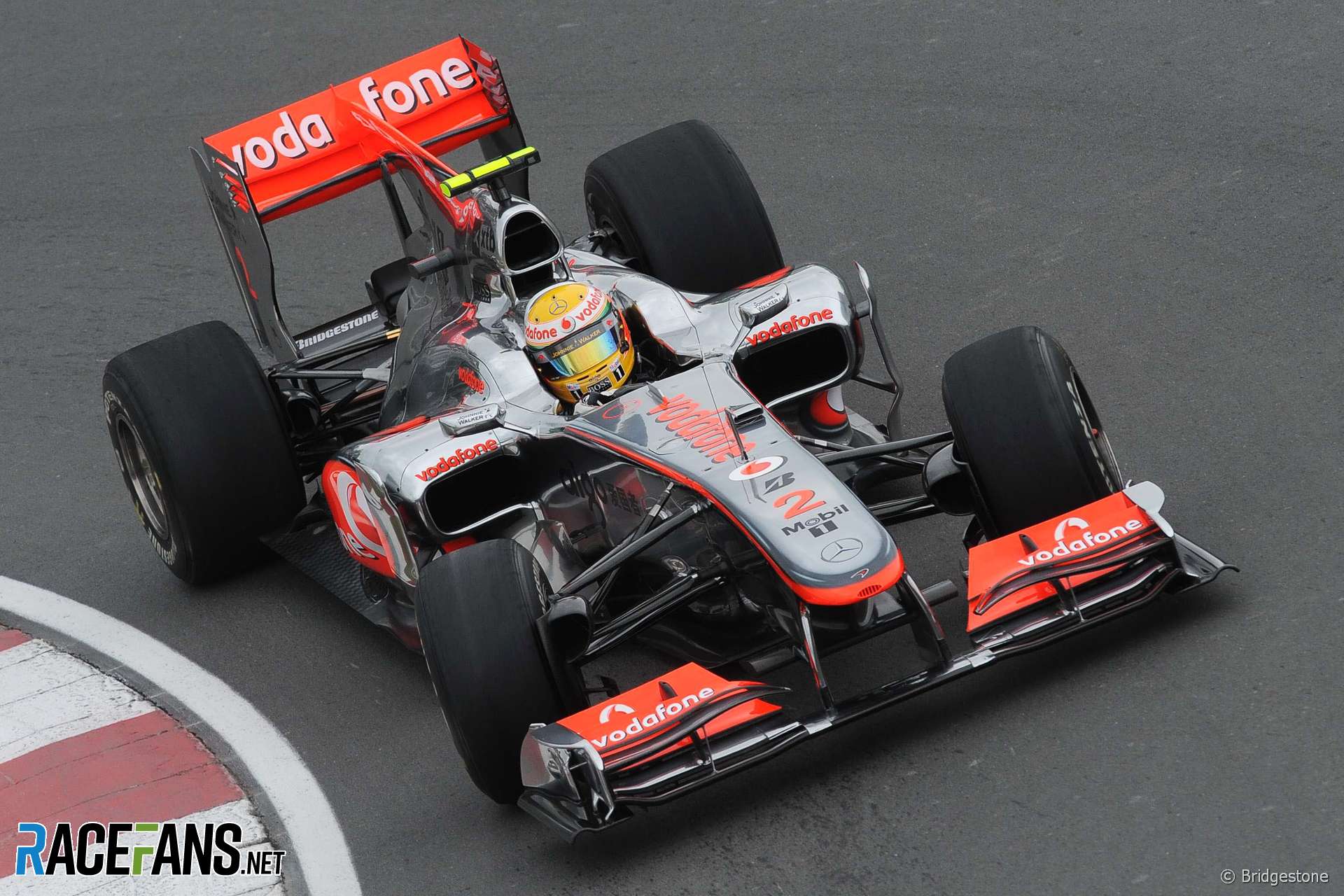
19 races, 5 wins, 1 pole, 454 points
KERS was temporarily banned in 2010 but McLaren cooked up another innovation – the F-duct. This was a cunning workaround of the aerodynamic rules which allowed its drivers to stall the airflow over its rear wing on straights to reduce drag and gain speed. Hamilton and his new team mate, reigning champion Jenson Button, wielded it superbly, winning five times.
But in this highly competitive season, Hamilton was one of four title contenders at the final race. Sebastian Vettel took the honours for Red Bull while Hamilton, counting the cost of a few earlier misfortunes, ended the year 16 points behind. However another development indicated change was coming for the McLaren-Mercedes relationship – the three-pointed star now had its own team, having purchased shock 2009 champions Brawn.
2011 McLaren MP4-26

19 races, 6 wins, 1 pole, 497 points
The MP4-26 was unveiled in an imaginative launch in Berlin’s Potsdamer Platz, where parts of the car were carried to the scene and assembled before the watching crowd. The sensitive parts were disguised, of course, and so much the better as its radical exhaust system didn’t work and had to be hurriedly replaced pre-season. Hamilton had a weirdly off-colour year, including several incidents, and Button led the charge against the dominant Red Bulls.
2012 McLaren MP4-27

20 races, 7 wins, 8 poles, 378 points
Victory for Button in the season-opener gave McLaren cause for encouragement. Two races later, however, Mercedes scored their first F1 win as an outright constructor since the fifties. Nonetheless McLaren remained the stronger team, and Hamilton briefly led the championship. Persistent reliability problems dogged his efforts and the title went to Vettel again.
Following overtures from Ross Brawn and Niki Lauda, Hamilton threw his lot in with Mercedes, a decision which mystified many at the time, but has since been vindicated in spectacular fashion. He should have won his last race for McLaren but was taken out by Nico Hulkenberg’s Force India. Button prevailed instead; eight seasons later, this remains McLaren’s most recent victory.
2013 McLaren MP4-28

19 races, 0 wins, 0 poles, 122 points
Sergio Perez arrived in place of Hamilton but McLaren were entering their wilderness years. No wins or poles came their way; in contrast, Mercedes’s works team managed three and eight respectively. The blame was pinned on the MP4-28 being a too-aggressive evolution of their largely successful 2012 machine. Particularly as the V8 era was drawing to a close, and a new generation of vastly more sophisticated power units were being ushered in.
2014 McLaren MP4-29

19 races, 0 wins, 0 poles, 181 points
The first year of the V6 hybrid turbo era was the final one for McLaren and Mercedes until the 2021 F1 season. McLaren were readying themselves for a reunion with Honda which promised a return to true works status.
In the meantime their 2014 campaign began well as both drivers finished the opening race in the top three – Button third, Kevin Magnussen second, the latter completing a neat symmetry by driving McLaren’s final Mercedes-powered car 19 years after his father drive their first. But that two-three result proved their best finish of the season. McLaren fell to fifth in the standings, far behind fellow Mercedes customers Williams.
To their dismay, McLaren found they had further to fall in the years to come. Meanwhile Mercedes soared ever higher after the pair went their separate ways.
Join the RaceFans Supporters Drive!
 If you've enjoyed RaceFans' motor sport coverage during 2020, please take a moment to find out more about our Supporter Drive.
If you've enjoyed RaceFans' motor sport coverage during 2020, please take a moment to find out more about our Supporter Drive.
We're aiming to welcome 3,000 new Supporters to help fund RaceFans so we can continue to produce quality, original, independent motorsport coverage. Here's what we're asking for and why - and how you can sign up:
F1 history
- How you rated F1’s 12 sprint races so far – and why two outscored the grand prix
- Alonso set to become F1’s oldest driver for more than 50 years
- From ‘Flying Pig’ to Senna’s heroics: The short, incredible history of Toleman
- From farcical to fantastic: Formula 1’s 14 title-deciding Japanese races ranked
- Benched: The five other drivers who stood down for team mates in last 50 years





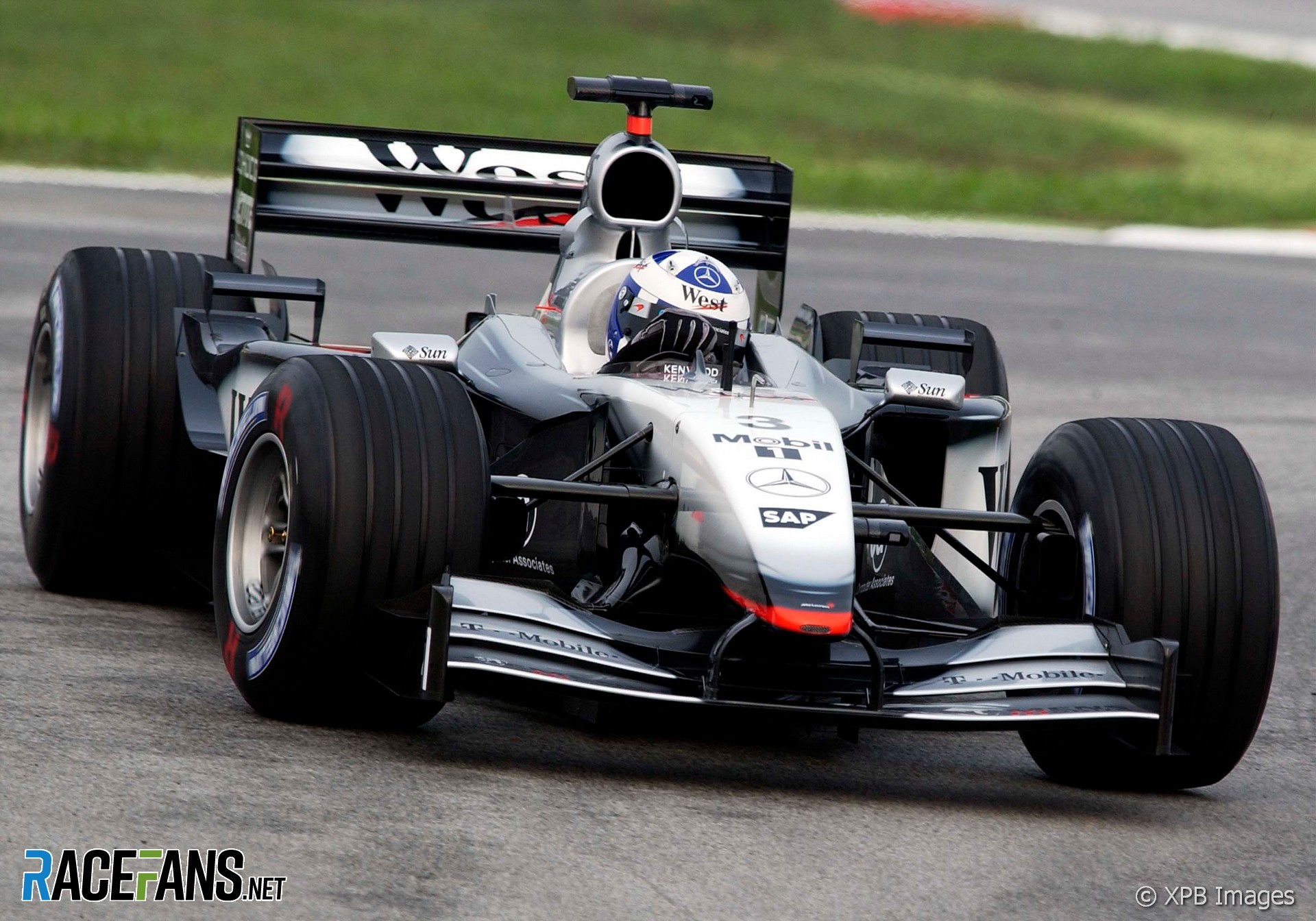

Ruben
15th February 2021, 7:57
Ooh, the 1998/1999 cars are so good looking without all the aero bits!
Interesting to see that the intersection of the front end of the monocoque is almost as square as monocoques are these days, but were much better integrated in the total design of the car then they seem to be nowadays.
Also: papaya and black makes a better combination than papaya and blue 😊
MacLeod (@macleod)
15th February 2021, 8:02
I find it a bit funny as everyone thinks McLaren will challange Red Bull for second while we don’t know how the transfer is going to work. It’s not chancing a engine is you have the same performance myself would watch the tests first.
If the Renault was much bigger then the Mercedes there is a good chance keep there performace but if the Mercedes is bigger expect problems.
Aiii (@)
15th February 2021, 8:23
I don’t know if anyone realistically believes this. But it would require them to find over half a second per lap on engine power alone and I don’t think the Renault was that slow, to be fair to them.
Last year got everyone all excited for the midfield because Ferrari fell out of the top 3 and joined them so they all moved up a spot, but if they get their act in order and with Sainz replacing the poorly performing Vettel, I would be surprised if third this year isn’t just going to be the red team and the midfield fight is going to return to fourth.
Until the effects of the 2022 rules in combination with the newly introduced budget caps come into effect, the status quo will be maintained for at least another season.
Aiii (@)
15th February 2021, 8:20
The MP4-13 will forever be my favourite F1 car, both in livery and design that thing is just absolutely stunning to me.
Jere (@jerejj)
15th February 2021, 8:54
@aiii Mine is MP4-20, followed by 25 and 26.
dot_com (@dot_com)
15th February 2021, 14:29
I loved the MP4-20 – JPM and Kimi were the best driver pairing, that was a great year.
Ancient1 (@ancient1)
15th February 2021, 13:53
Can’t disagree. Those West cars looked absolutely magnificent, particularly in the flesh. Just could not come at those Mika & David liveries though. Love him or not, one could only respect Ron Dennis for the professionalism & passion he put into the McLaren, 24/7. Understood he spent mega$$’s on the liveries so they looked perfect on TV.
It’s ironic, but as an Aussie, i could never understand why Bruce McLaren chose papaya. Black, yes, a la the Ford GT40 he shared with fellow Kiwi Chris Amon in winning the ’66 Le Mans 24hrs.
Come on Dan, have a ripper ’21!!!
dot_com (@dot_com)
15th February 2021, 14:26
One of my favorites too. My first full season as a F1 fan, watching Mika in that Mclaren was just a perfect thing.
Sensord4notbeingafanboi (@peartree)
15th February 2021, 15:43
Looks like a narrow mp4-12. Mclaren missed the roll hoop loophole so the car had those ugly imo lumps on the side, that aside, I find the 97 car better looking.
Mick
15th February 2021, 8:29
Reminds me of the hype surrounding McLaren/Renault reuniting. Hope this works out better, as an Aussie I have my hopes riding on this partnership
Mick
15th February 2021, 9:53
Sorry I meant Honda
Tony Mansell (@tonymansell)
15th February 2021, 9:06
Beautifully put together, but the last pretty car was 2006 and obviously 2014 was a catastrophe. Marry that to the sounds of the v10s to todays hybrid noise. Depressing
Fer no.65 (@fer-no65)
15th February 2021, 9:32
You quickly go through all the pictures, all very nice cars, then you get to 2009 “uuuuuugh!”… and it all improves slightly but then 2014 “uuuuuuuuuuuuuugh!”
It’s a good thing I’ve totally erased 2014 from my mind… Can’t believe we went a whole year looking at noses like those!
Fer no.65 (@fer-no65)
15th February 2021, 9:33
Also, I always find the 1996 very funny looking. That famous Marlboro livery on such a modern shape, somehow doesn’t fit well.
KaIIe (@kaiie)
16th February 2021, 16:57
Yeah, the ’96 cars suffer from some questionable design choices combined with the new-ish safety regulations. Things like the raised cockpit sides make them simply look off (though, in a way, I kinda like them).
petebaldwin (@)
15th February 2021, 11:24
Yeah it’s funny – we all sort of got used to the ridiculous looking cars in 2014 (and to a lesser extent 2009) but once you’ve had a break from seeing them and look back at pictures, they look as bad as when I saw them for the first time. It’s unbelievable that F1 ran with cars as ugly as that….
Pedro80R
15th February 2021, 12:51
2009? Got to 2006 and almost quit reading the rest…. the last good looking cars were the 2005 season ones, albeit some exceptions… the aerobeasts of today are really ugly…
Tommy C (@tommy-c)
15th February 2021, 9:40
Some cracking and iconic cars here. This was the era I fell in love with F1. Mclaren was always my team and Hakkinen was the main man when I was getting into the sport. My favourite was the MP4-20 and it was this car in Raikkonen’s hands in Japan that hooked me to the sport forever and converted me from a fan to fanatic. In fact, I’m pretty sure I stumbled on F1Fanatic.co.uk looking for a decent hi-res image of the MP4-20 for my desktop background! Such an elegant design. Definitely in my top 5 favourite cars of all time.
Qeki (@qeki)
15th February 2021, 9:42
What is it with Mclaren Mercedes and Finns or Brits :)
Dean F
15th February 2021, 10:04
Just my opinion of course (some people get upset when I have one) but the McLaren was the quickest car in 2000. Without a doubt. Schumacher was the difference in Ferrari winning.
McLaren had the edge at Spa, Ferrari probably had a tiny edge at Monza because of the refrigerated fuel that was subsequently banned, Indy Coulthard jumped the start and Hakkinen had better pace as the track dried out before his engine blew up, Japan the McLaren had the edge it was just Schumacher brilliance that he could keep up with the McLaren, Schumacher had the edge in the changeable conditions as he always, Malaysia is a tough one Hakkinen jumped the start with Coulthard finishing just behind Schumacher. You’d have to say McLaren had a clear edge Hakkinen would have won if he didn’t jump the start.
Tommy C (@tommy-c)
15th February 2021, 11:10
I don’t think that’s particularly controversial. They were pretty evenly matched packages. I think you could make the same argument for 2006 where I think Alonso made the difference.
theeselsunrise
15th February 2021, 17:15
Agreed re 2000. In 2006, Renault were stronger pre-Mass Damper ban, then Ferrari were stronger in the second part of the season, but Alonso and a few off-days for Michael gave the title to Renault.
Sensord4notbeingafanboi (@peartree)
15th February 2021, 15:51
I think McLaren always had a big advantage on power.
anon
15th February 2021, 20:11
@peartree Mercedes did not have an advantage in terms of peak power – we know that because of the data that Illien has published in the past, and also because there are dyno results for some of Ferrari’s engines of that period (along with Peter Wright’s rather extensive assessment of Ferrari’s car in 2000).
What that data shows is that Ferrari and Mercedes were similar in terms of peak power – if anything, Ferrari were the ones with a slight peak power advantage, not Mercedes, during that period. The Tipo 046/2, for example, was just as powerful as the Mercedes FO110F – by the time you get to 2000, the Ferrari Tipo 049 was producing a few bhp more than the Mercedes FO110J.
After that, the power advantage shifts quite decisively in Ferrari’s favour after the ban on the use of beryllium alloys for engine components went through in the early 2000s, where Mercedes was pretty much the only ones who were losing out from that ban.
theeselsunrise
15th February 2021, 17:18
Maybe McLaren were not quite much better, but overall better. The previous two seasons, there was a bigger gap – Schumacher was superb in 1998.
Paul (@frankjaeger)
15th February 2021, 10:28
That 2014 car is as disgusting now and it was…
But those heritage liveries on those noughties cars…WOW
DB-C90 (@dbradock)
15th February 2021, 12:12
I just don’t see 2021 being all that good for them. Using all their tokens to fit the new PU doesn’t leave any room for improvement if it’s not 100% spot on from day 1.
Glad they’re getting the transition out of the way though before 2022 so all they’ll have to do is focus on the new chassis.
S
15th February 2021, 13:26
What I wouldn’t give to have F1 cars that size and weight again…
And the simplicity of the body and aero of the earlier cars….
F1 – look what you’ve done to yourself since then. :(
Holmzini
15th February 2021, 14:59
So Aiii I figured out why your fond of of the MP4/29. I understand the ground effects were less than desired for the center of balance was found to be way forward of the center of gravity. So if they had understood that clearly the balance issue could have adjusted for. Such a bizarre looking Racecar. So go ahead Aiii you are the one who likes the 29 a lot.
Sensord4notbeingafanboi (@peartree)
15th February 2021, 15:48
And the late 90’s early 2000 mclaren steering wheels, and the cockpit views were amazing.